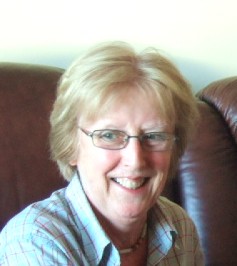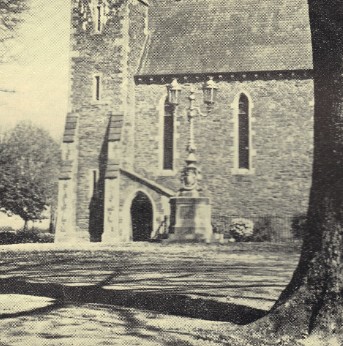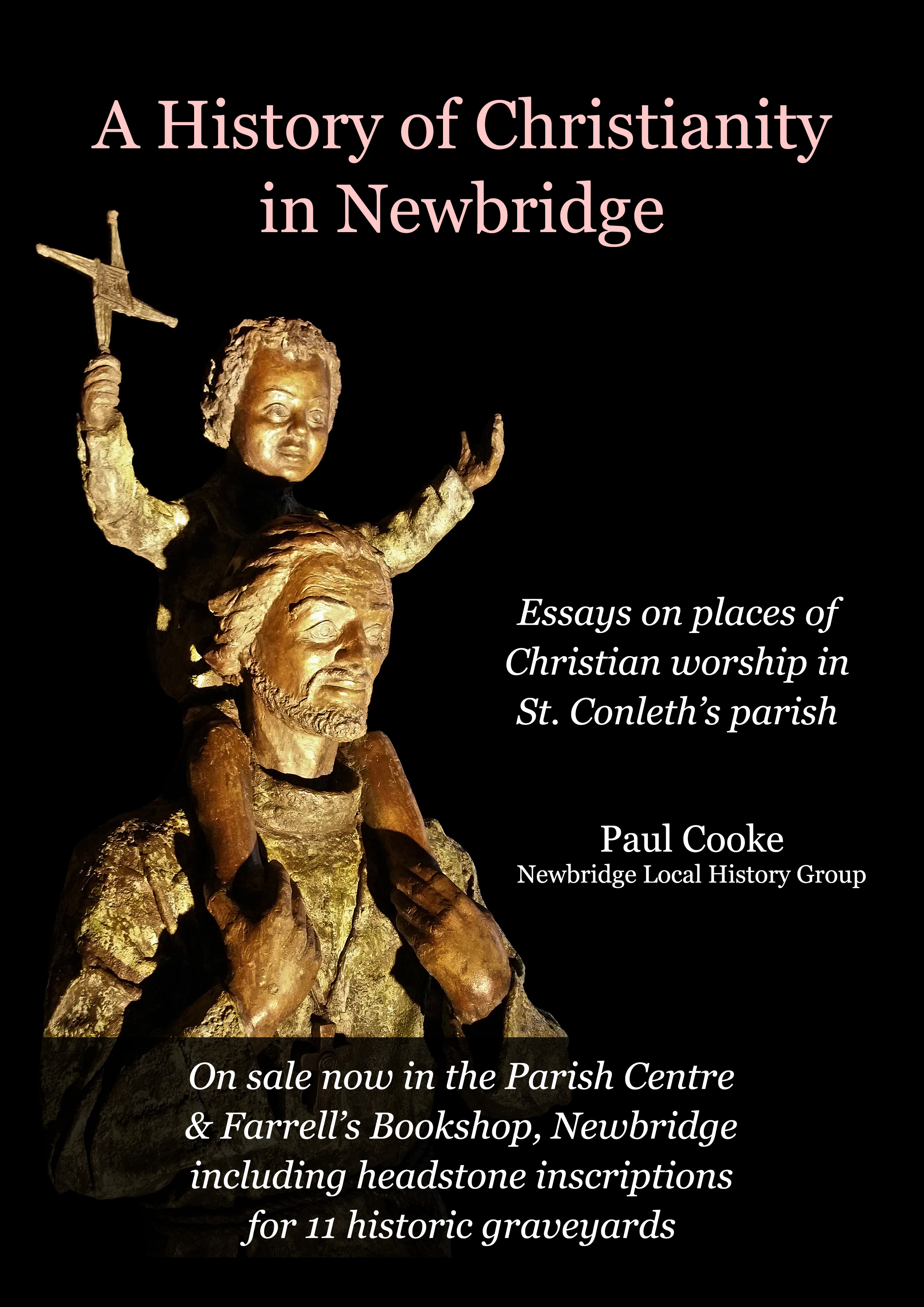Brenda Cleary: Childhood pursuits, 1950s.
Brenda Cleary (nee Davis)

One of my earliest memories was in 1947, when my father brought me to see the River Liffey that was frozen over and people were skating on the ice.
I was born in Gordon House on Moorefield Road, near Roycrofts. A Dr Murphy( from Cork) owned the house we were living in, and he wanted it back. So we moved to ‘St Mary’s’ on Henry St. That was built by Sheridans, who had built all of Artillery Place and the houses on the Curragh Camp – the bricks were all the same. They lived out in Crotanstown House, and my mother used to say they would come into town on their horses, wearing yellow gloves, to call on their tenants.
Mrs Wylie lived beside us. She was a nurse, and had a dog called ‘Tuppence’. Her garden was full of roses, and she would sit out there behind them. She wore a great cloak (she also gave Matty Nolan a beautiful, valuable, set of books about Ireland, that he later lent to someone and never got them back).
I fondly remember going to Mass in the old Dominican church – it had a wonderful old world charm and boasted of a great choir; their music master was Dr Kuypers, who lived in the College. One of the main singers was Nancy Moore. One of my abiding memories of this church was entering at the side door and lighting candles for inspiration as our class from the girls ‘Secondary Top’ did our Inter Cert in the College that year, which I think was the only time this ever happened.
As one went through the main gate of the College, there was a large grotto of Our Lady on the left, and at Christmas it housed a large crib. At the centre of the forecourt was a big round monument, which we as children loved to run around.

Another event was the annual Sports Day in the College, which was held in the field opposite the main entrance, beside the College farm. This day also involved prize giving to the pupils, and the afternoon was rounded off with afternoon tea in the College refectory. Somehow the sun always seemed to shine on that day.
Another even which occurred was the annual May Procession. This took place in the grounds of the nun’s residence and wended its way past Monsignor Millar’s house and through the nun’s garden. We would be dressed in our finest white dresses and veils, and the ‘Children of Mary’ were there in their blue and white uniforms. We would scatter flower petals along the path of the procession. These petals would have come from plants grown in the glass corridor connecting the convent to the side of the Church where the nuns had their own entrance. Monsignor Millar, a quiet-spoken but strict man, led the procession. He would not allow music to be played at weddings in his church.
The original infant school for boys and girls was situated on the left-hand side of the nun’s convent. Eventually it was just for girls, and I remember at one stage our classroom was a blue painted wooden room away from the main school, and it was called ‘St Margarets’.
We were only in the new school for 6th class, and we thought it was heaven.
We did our Inter Cert down in the College, with the boys. I remember Sr Benedict standing on the bridge crying, waving to us as we trooped along Rowan Tce. She had her white handkie out, sobbing.
On our way to and from playing in what was called ‘the Jungle’, at the back of Moore Park, we occasionally called in to the forge to see the red hot fire burning and the men working on the horse-shoes.
Another activity I remember from those far-off days was the Sunday morning games of ‘Pitch-and-Toss’, which were held at the entrance to the train station. There was one entrance for vehicles and one for pedestrians, and the latter was a narrow walkway between two high walls. This is where the ‘Pitch-and-Toss’ took place. It was an illegal activity so there was a constant look out for the Garda who might arrive on his bike and put a stop to the proceedings.
During the summer holidays many of the local boys would go and work on the bog, cutting and stacking the turf. After getting up at the crack of dawn to make the sandwiches, they would be collected by a lorry that would take them off for the day’s work. I’m sure the money was not good, but it gave them pocket money for the holidays.
As there was not much traffic, another pastime was ‘Hop Scotch’. We played this on the road – we could mark out the pattern with chalk – and this could pass many hours of playtime until my grandma would call us in and make us the most beautiful omelette made from the fresh eggs delivered to her door. She would top this with homemade jam – delicious!
We spent many hours, too, with skipping ropes. We all had bikes back then and we went everywhere on them. We would take off after dinner, which most people had at midday, and we would be gone for hours. We even cycled to Naas to play tennis. Another place we loved to cycle to, was the Hill of Allen, where we could climb to the top of the tower. The view was terrific!
At other times we would go out on our roller skates, out past the College and spent hours on that road out as far as St Patrick’s Well. We chose that road as it had a very long straight stretch and at the end of a long day we could have a drink of pure cold water from the Well.
Irene Rogers and I used to roller-skate; you could skate from the Bank corner all the way down to the Liffey and no one would ever say a word. The only problem would be the drunks! Up at Neeson’s corner you had the ‘corner boys’ – those who had a few drinks and hung about at the corner before going to the bookies nearby.
A legacy of the aftermath of the war was that many people had ‘plots’ – quite a large piece of ground in which vegetables were grown. Owners were very proud of their patch of ground and they kept them in great condition, well dug and weed free. These ‘plots’ were located to the right of the Irish Ropes factory, where there was nothing but green fields. Another follow-on from that was the McCormick Brothers who lived in Henry St. They had a large premises at the back of their house filled with fruit and vegetables and they would sell these from house to house in their van.
On Saturday morning a man would come around on his bike selling rabbits which he had snared the night before. Another man, Paddy Heavey, would also come along on his bike and deliver milk from his billy-can – no pasteurisation there! He would also sell fresh eggs to my grandma, and she would give him scraps of food left over from the week, which he would take home to feed his chickens.
For entertainment there was the yearly visit of the Circus in Ryan’s Field, on the Station Road. This was a show we looked forward to from year to year. We loved to watch the Big Tent being erected, and couldn’t wait for the show.
Another event was Derby Day in the Curragh, where many famous people would attend. There was great excitement when Grace Kelly attended, and came through Newbridge en route to the course. She shook hands with people in the town; she was just beautiful.
There were dances in the Town Hall. This was originally the British Army garrison church. All of the top bands played there, and during the dance there was the famous ‘supper’, which consisted of ham sandwiches and a mineral or tea. If you were asked would you like this supper you were really made up, as they say.
Newbridge was a truly remarkable and marvellous place in which to grow up. We had terrific freedom. Most of the time we spend in the top tennis club, which was built in Cox’s Field. People associated with the ‘Top’ tennis club: Liam Murphy (who later became a Dominican, and was considered a ‘moral watchdog’); the Kearn’s; Kay Prendergast; the Bradley’s; Davy and Joe Dolan; the Flynn’s; the Davis’s; Nolan’s; the McDonald’s; the Waldren’s; the Rogers’s; Kirwin’s; Delaney’s; Corcoran’s; and the McGowan’s. We didn’t get involved in the administration, we just played tennis and socialised. The Corcoran’s were one of the few to cross the divide, they lived in the lower end of town but played tennis with the ‘Top’. Ann O’Connor and Mary Kearns also came up. Literally, we spent morning, noon and nights there. We had tournaments, ‘hops’, friendly games, and lots of time looking for lost tennis balls. The sun always seemed to shine. We even cycled over to Naas to play there. ‘Angela’s’ shop (Angela Doyle) was just beside us so we could buy our soft drinks and ice cream. Fr McNally used to call from time to time.
In the tennis club, during the summer, gangs of us used to go off on bicycles – the the Seven Springs, to St Patrick’s Well, out by Baroda Stud, and so forth. Once we went to Blackers, in Kilcullen (now Tony O’Reilly’s place). It was supposed to be haunted. There was a house (a bungalow) on the road to Kilcullen that was also supposed to be haunted. The story about the Blackers was that the family was supposed to have been on ‘their uppers’ and Mrs Blacker decided to have a séance. She used a girl from the Bog of Allen as a medium. The house had to be exorcised later.
You could walk the Liffey from Newbridge to Kilcullen. We went out beyond Kilcullen for a picnic once, in August 1959 – Frank McGowan, Brian McGowan, Ann Waldron, Eileen Rogers, Jackie Hayes, George Kirwan, Christy Moore, Ken Lawlor, Barbara Bradley, Maureen Hayes, Turlough McGowan, Noelle Ward (who later married Frank McGowan), Maurice O’Neill, Seamus Flynn and Bobby Neiland (who later married Barbara Bradley).
Brenda Cleary (C) 2010.

